
Travel
Lively Lisbon
Experiencing
Portuguese Culture
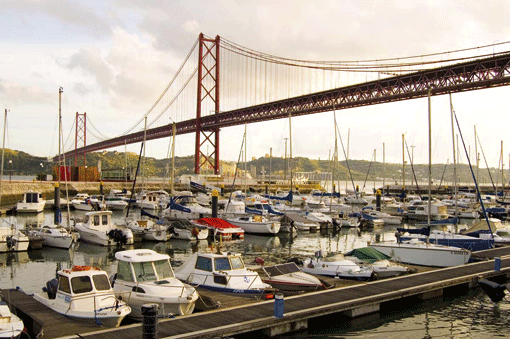
Lively Lisbon, Portugal’s capital lies in the southwest of the country on the Atlantic.
Greater Lisbon has a population of 3.5 million and is built on seven hills occupying an area
of some 1,000 square kilometres.
By: Veronica Maria Garbutt
Resting on the banks of the River Tejo is the city’s fin-de-siècle architecture-lines-cobbled-streets with yellow trams, chunking up and down the hills. Low rents permit small shops specialising in gloves, fish or musical instruments exist alongside velvet-lined restaurants and Baroque cafés. And African and Brazilian culture permeates Lisbon life, influencing its artistic scene and cuisine while adding vibrant colour, verve and energy.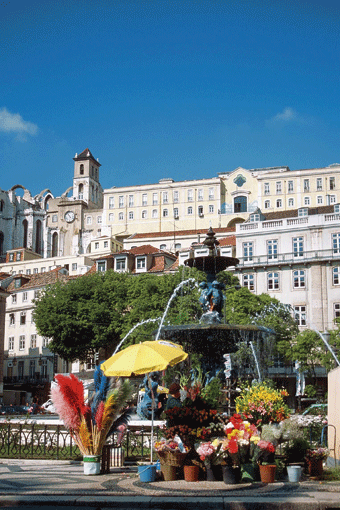
Lisbon’s history goes back to the Phoenicians who settled there some 3,000 years ago and called the city Alis Ubbo (Delightful Shore). Later came the Greeks, Carthaginians and in 205 CE the Romans who stayed until 5th century CE. North African Arabs arrived in 714, fortified the city and called it Lissabona. In 1147, a local lord Dom Alfonso Henriques took the city and Alfonso III moved the capital there from Coimbra in 1260. After Vasco de Gama discovered a sea route to India, Lisbon boomed as the capital of a vast empire until 1755 when a major earthquake hit.
The Marques de Pombal rebuilt the city inexpensively in a formal grid pattern. Napoleon’s forces occupied the city in 1807. In the early 20th century there were many changes of government. After independence of the former colonies in 1974-75 there was a massive influx of immigrants from Mozambique, Brazil, Goa, Macao, Angola and the Cape Verde Islands. Since Portugal joined the EU in 1986 European funding has helped improve infrastructure and transportation. The country is so far moderately industrialised and the main exports are cork, timber, textiles, pulp, footwear and machinery.
Alfama, the old haphazard, medina-like part of Lisbon, should not be missed. Its narrow cobbled streets lead up to St George’s Castle. The city grew outwards from the castle, the first walls of which were built by Visigoths before the site was conquered by Romans, Arabs and later Portuguese. The district’s distinctive Arab legacy is shown by its name which is derived from Al-Hama meaning ‘bath’ or ‘spring’. Once an upmarket Arab residential district, it reverted to a working and fisherfolk quarter after the earthquake. Its steep alleyways are worlds away from the tidy European grids of other parts of the capital.
For an overview of the district, head to the splendid belvedere—Miradouro da Graca—and relax at the café tables under the pines. Worth visiting also, is the nearby Pantaeo Nacionial which contain marble cenotaphs to figurines such as Henry the Navigator and Vasco de Gama. And admission is free to the Castelo de San Jorge where it is fun to clamber over the battlements and open courtyards filled with trees and birdsong. On Tuesday and Saturday mornings, the Fiera de Ladra flea market takes place on Campo de Santa Clara. Look out for wrought iron work, prints and tiles which are among the best buys here.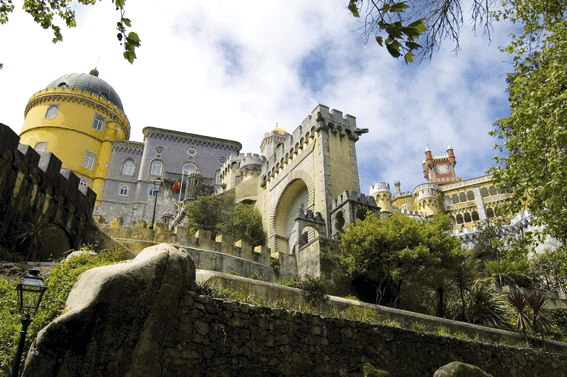
Following the earthquake, the city centre or Baixa was rebuilt from the riverside to Rossio. The grid’s streets took their names from the crafts and trades of the district—Rua des Supateiras is Cobblers’ Street, Rua da Prata is Silversmiths Street and there are streets dedicated to Aurea (Gold), Correeiros (Saddlers), Fanqueiros (Cutlers) and Douradores (Gilders) too. Although modern banks and office blocks predominate, many traditional shops remain. For instance, the central part of Rua do Conceicao is still lined with stores selling beads and sequins.
The stunning arcaded Praca do Comercio is the apogee of Pombal’s design. Formerly its buildings housed a royal palace and the waterfront is a popular place just before sunset. Then the denizens linger in the golden light to watch the ferries ply between the Estacao Fluvial and Barreiro on the opposite bank of the Tejo. The square is also the starting points for city tours, home to the Lisbon Tourist Office and the main venue of the New Year’s Eve fireworks. Other interesting points are the Praca do Municipio, the Roman remains on Rua Agusto and the Elevador de Santa Justa. At the top is a rooftop café with a dazzling view of the city.
Since medieval times Rossio has been the hub of commercial Lisbon. And during the 19th century its plethora of cafés attracted the city’s writers and artists. Today, Africans gather around the Teatro Nacional Doña Maria II, to catch the latest news from Mozambique and Angola. The grandest square however is Praca do Comercio, an architectural testimony to Portugal’s 18th century wealth and might. It was designed with one side open to the river and the other three for government ministries. In the northeast corner of the square, Café Martinho da Arcada was a regular haunt of the iconic Portuguese poet, Fernando Pessoa, in the 1920s and 30s.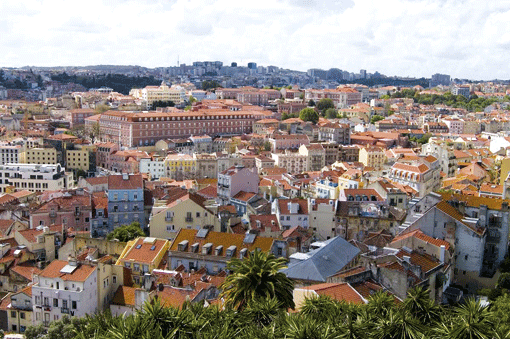
From the Baixa it’s a steep climb west through the smart shopping district of Chindo into Bairro Alto. The Avenîdo da Liberdade, the city’s main avenue, leads north out of the Baixa into the commercial districts known as the new avenues. Carrying several lanes of traffic between the Praca dos Restauradores and the Praca Marques de Pombal roundabout, this is Lisbon’s Champs Elysees, home to office blocks, plush hotels and upmarket fashion boutiques. Adjacent to the roundabout, lies the Parque Eduardo VII where the Estufa Fria greenhouse gardens provide welcome shade in summer.
The riverside area heading west out of the city between Santos and Alcantara has been renovated and offers many sophisticated cafés and restaurants. On the dockside area beneath the 25 April Bridge you can enjoy salted cod, stuffed spider crabs and octopus salad al fresco. If you care to venture out on the River Tejo, several boat trips are available. Or you can catch regular river ferries from Praca do Comercio and from Cais do Sodre. Taxis have metred rates and are inexpensive by European standards. And a tram ride, slowly grinding up the slopes and rattling down again, is a must.
Before leaving, don’t miss a visit to the Museum of Azulejos. Illustrating the history and development of tiles, the place showcases pieces ranging from early Ottoman geometric designs to stunning blue and yellow and Goan pieces. The pièce de resistance is undoubtedly a 36-metre artwork illustrating pre-earthquake Lisbon. The Calouste Gubenkian Museum houses over 3,000 items from the collection of the Armedian tycoon of the same name and the Carris Museum on Rua 1 de Maio recounts the story of Lisbon’s most endearing means of transport—the clunking atmospheric tram which recalls a bygone era.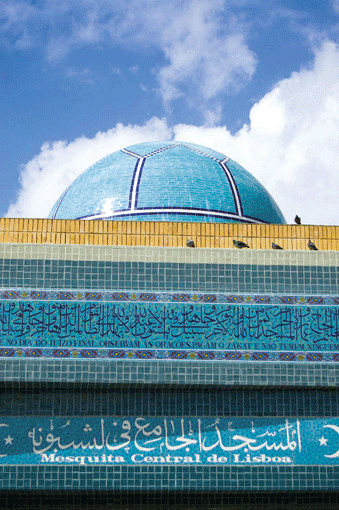
Heading west out of Lisbon, a short ride by bus, train, tram or taxi, is Belem, one of the capital’s most visited suburbs. It was from Belem that Vasco de Gama set sail for India in 1497. He returned with a cargo of pepper that made enough profit to pay for the voyage 60 times over. The area is home to the UNESCO-listed Belem Tower completed during the Manueline period. Arabic influence can be seen in the structures intricately arched windows and balconies. Other places of interest include the opulent Coach Museum, the Monument to the Discoveries, Electricity Museum and Ajuda Botanic Garden. And no visit to Belem is complete without a coffee and hot pastel de nata (cinnamon dusted tart) at the cavernous blue-tiled Antiga Confeitaria de Belem.
Cascais and Estoril are seaside resorts 25km west of the capital. Estoril’s town centre is focussed on the leafy Parque do Estoril, surrounded by cafés and restaurants. With its find sandy beach—Praia de Tamariz—backed by a seafront promenade that stretches all the way to Cascais, this Estorial coast likes to style itself as the Portuguese Riveriera. Cascais, meanwhile, is a quaint former fishing village with royal connections and abundant charm. In summer, this livelier of the two resorts, is crowded with lots of Lisboetas plus surfers and golfers from further afield. Don’t miss the auction at the fish market held daily except Sunday at 6pm.
The Estoril coast boasts a dozen fine golf courses. Golf do Estoril offers 27 holes designed by McKenzie Ross in 1935 and is set amid eucalyptus, pine and mimosa trees. It has hosted the Portuguese Open many times and calls for careful tactics and course management to ensure a good score. Some 9 km to the west, the Quinta da Marinha Golf lies adjacent to another state-of-the-art resort of the same name. Set amid the centennial pine woods of the Sintra mountain range, this 6,419 yard par 71 course was designed by Robert Trent Jones Jr.
Sintra, some 28km northwest of Lisbon was described by Lord Byron as ‘a Glorious Eden’. The National and Peña palaces and Moorish Castle are UNESCO heritage listed sites and the tropical gardens are memorable. This fairytale hilltop town of parks, palaces and gardens can be easily reached by train from Rossio Station in the Baixa.